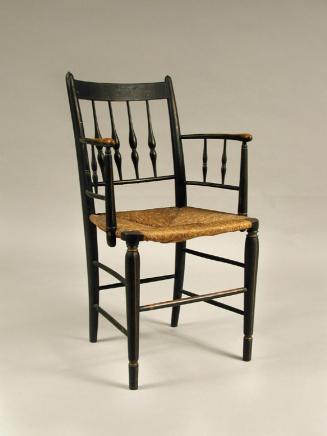Great Chair
Furniture MakerMade by
Unknown
Date1650-1700
MediumAsh, rush
DimensionsPrimary Dimensions (overall height x width x depth): 42 5/16 x 24 1/8 x 18 3/4in. (107.5 x 61.3 x 47.6cm)
ClassificationsFurniture
Credit LineBequest of George Dudley Seymour
Object number1945.1.1138
DescriptionAsh great chair in the seventeenth-century style, with turned stiles, rails, arms, front legs, and spindles, and a rush seat. The back of the chair is formed by two turned stiles, each with a ball-shaped finial at the top. Between the stiles are two rails, over three spindles, over a rail. The top rail and spindles are turned with ring-and-baluster forms. Above the seat, the stiles are turned with ring, baluster and cylinder forms. Below the seat, the straight stiles extend down to form the cylindrical back legs. Each arm slopes downward and extends between the stiles and the arm support, or upper portion of the front legs. Each arm is turned with a central cylinder flanked by a ball. Each front leg is turned with a ball-shaped handhold over cylinder, baluster and ring forms. Above the seat, each front leg supports the arm. The chair has a trapezoidal rush seat. The front and each side of the chair has two plain turned stretchers connecting the lower legs. The back of the chair has a single plain, turned stretcher.
Condition: The feet are worn, and damaged; the rear feet and front right foot have been repaired with glue. The top rail on the back and the right spindle are worn. The top front stretcher is worn. The frame is refinished and the rush is replaced.
Design and Construction Details: The rails that form the back of the armchair are tenoned into the upper stiles; the spindles are tenoned into the rails above and below. Each arm is tenoned into the stile at the back and into the upper front leg at the front. Each seat rail is tenoned into the upper legs. Each stretcher is tenoned into the lower legs. The armchair has a built-in layback, meaning that the arms, side seat rails and side stretchers are joined to the stiles at an angle to make the seat lean back.
NotesHistorical Note: This type of chair is known as a "Carver chair", defined as a turned chair with three spindles in the back. The name Carver became associated with this form during the nineteenth century because of an example in Pilgrim Hall, Plymouth, Massachusetts, named after the first governor of the colony, John Carver.Condition: The feet are worn, and damaged; the rear feet and front right foot have been repaired with glue. The top rail on the back and the right spindle are worn. The top front stretcher is worn. The frame is refinished and the rush is replaced.
Design and Construction Details: The rails that form the back of the armchair are tenoned into the upper stiles; the spindles are tenoned into the rails above and below. Each arm is tenoned into the stile at the back and into the upper front leg at the front. Each seat rail is tenoned into the upper legs. Each stretcher is tenoned into the lower legs. The armchair has a built-in layback, meaning that the arms, side seat rails and side stretchers are joined to the stiles at an angle to make the seat lean back.
Status
Not on view












